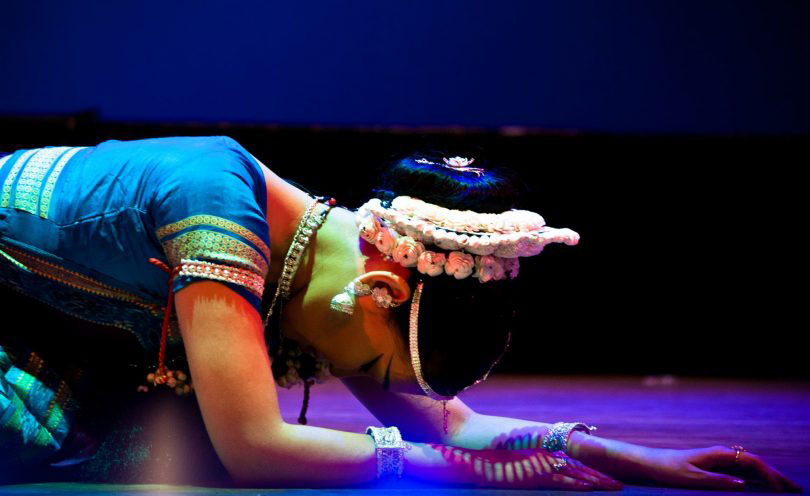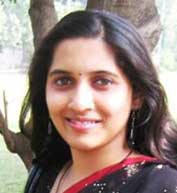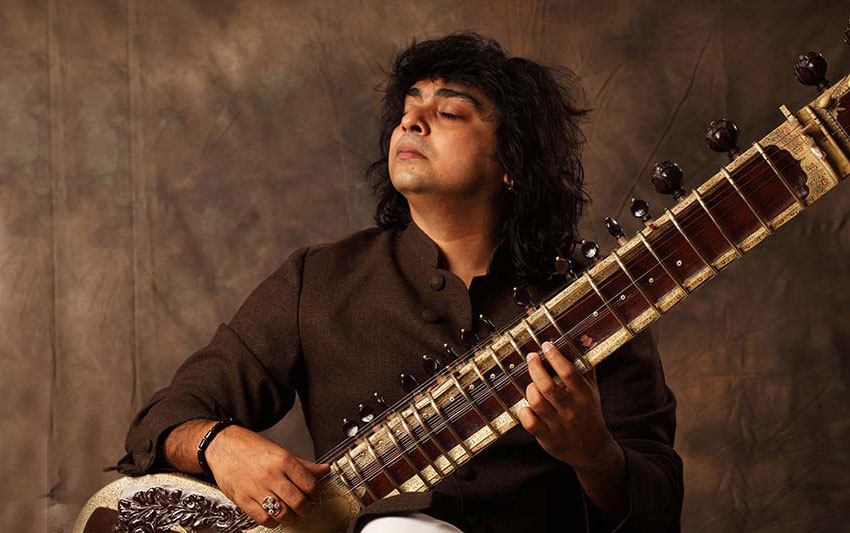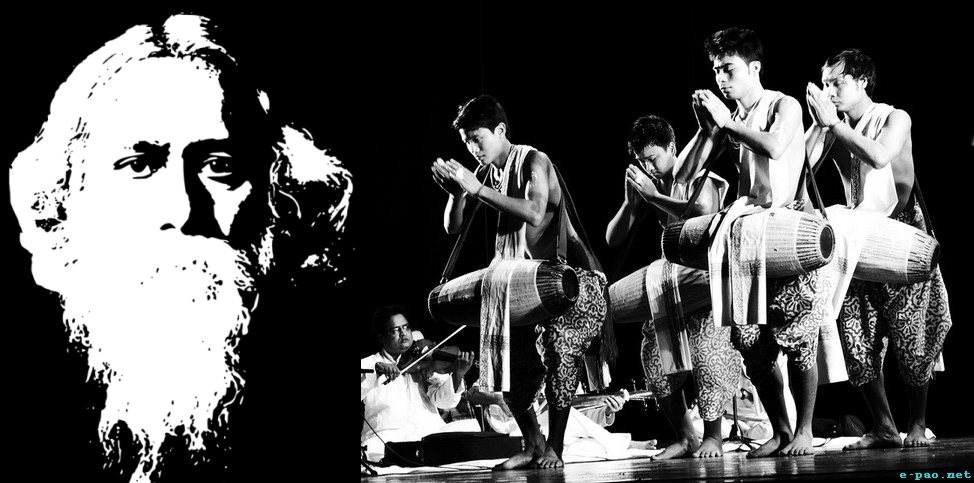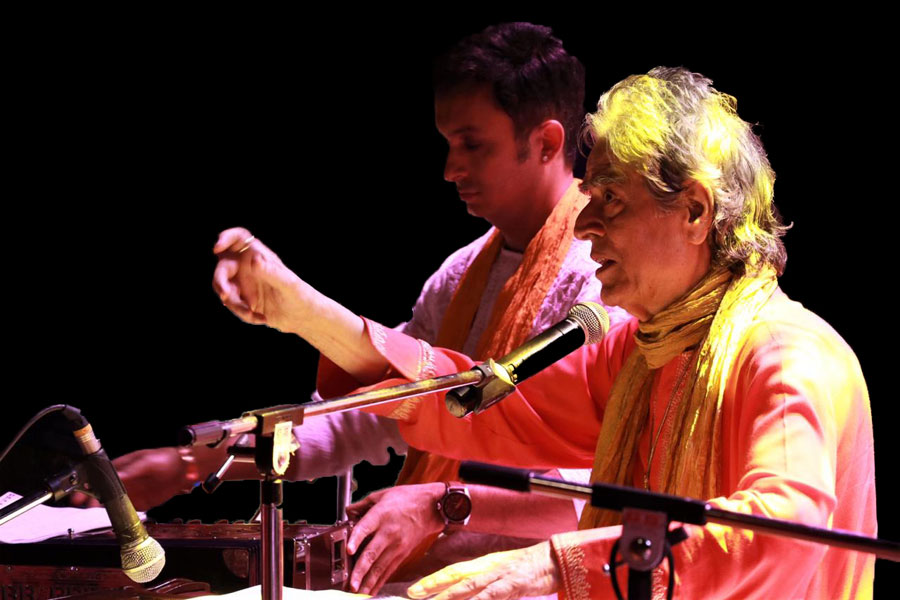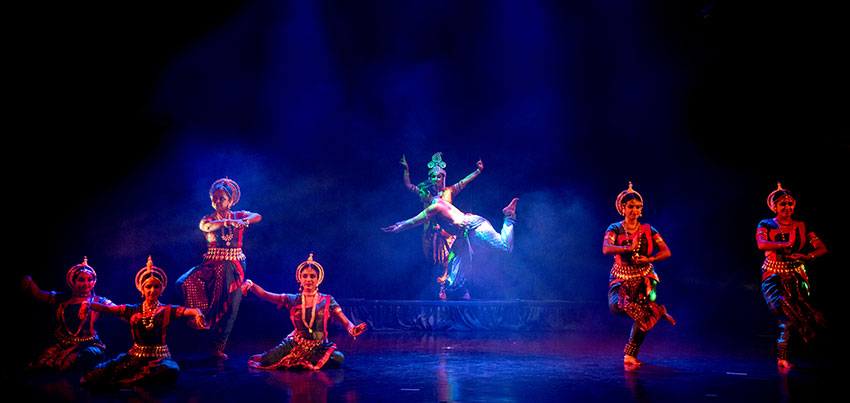गुरुर्ब्रह्मा गुरुर्विष्णु गुरुर्देवो महेश्वरः । गुरु: साक्षात् परब्रह्म तस्मै श्रीगुरवे नमः ।।
Guru Brahma, Guru Vishnu, Guru devo Maheshwara|
Guru sakshat, para Brahma, tasmai shri gurave namah|
Which means that, Guru is the Brahma (source of our creation), Vishu (force of preservation), Maheshwara (destroys the darkness of ignorance); I bow down to the Guru who is real and ultimate truth (beyond the beyond)… Indeed, in the context of Indian performing classical arts; Guru has always been believed equivalent to the God; ultimate reality and almighty! Guru is the remover of darkness: ‘Gu’ means darkness, and ‘Ru’ means remover. Darkness refers to lack of knowledge, ignorance, lack of awareness and directionless in life; Guru helps us in becoming self-aware, find purpose in life and achieve the ultimate goal of self-enlightenment! Guru is the one; who guides us on a virtuous path of life, mentors us to find meaning of our being, shares his/her wisdom with us and we learn a lot just by the presence and observation of our Guru… Thus in Indian culture, we worship and surrender ourselves in the service of our Guru! ‘Guru Purnima’ is the occasion when we remember our Gurus and celebrate the day in honor of our Gurus by paying a tribute to them, offering Guru Dakshina in form of our love, commitment to being loyal and faithful to their teachings and immense respect towards them!
This day is also known as ‘Vyas Purnima’ as it marks the birth anniversary of the great Guru- Maharshi Vyas in old time… Guru-shishya parampara (tradition) has been the strong backbone of all our Indian education disciplines; especially in Indian classical art forms- music, dance, fine art, etc. Guru-shishya (teacher-disciple) relationship has also been believed as one of the most sacred relationships of our lives.
Just like any other tradition, Guru-shishya parampara is also changing with rapidly changing times! Earlier, disciples used to stay with the Guru in a Gurukul where they didn’t only learn the topic/particular subject of interest but they were also trained in different life skills, virtues of life and were prepared to be a good human being apart from mastering the particular subject of teaching.
But now in formal education system, the concept of Gurukul has become old and there are very few Gurukuls available. When we talk about Indian classical music and dance; Gurukul has changed to university education/formal institutions where usually students go and attend the lessons for a limited time during the week. With an advance of technology, teachers are also offering lessons on skype/youtube where students learn through virtual learning sessions.
With ever changing and competitive time, we need to embrace the change in the Guru-shishya tradition as well! Nowadays we also don’t see a lot of disciples going for ‘ganda-bandhan’- traditionally a ceremony where a disciple was entitled be with only one Guru, be faithful to him/her and wasn’t encouraged to seek learning from any other Guru… This was the commitment of Sadhana (efforts and devotion), time, and shared knowledge from the disciple (Sadhaka/Shishya) as well as from the Guru! But in today’s era, people are open to change different dance styles/disciplines (gharanas), gurus or also seek guidance from multiple Gurus, change Guru for higher education, etc. Versatility of knowledge and in the presentation of an art form has been given more importance; thus this also seems to be the need of the time! This does not mean, constantly changing Gurus or being unstable in the process of learning is encouraged; but Gurus and shishyas have become more open with regard to choosing an institution/guru/style of performing art, etc.
In the classical music and dance fraternity, some are embracing these changes in Guru-shishya tradition where some still believe and follow the old, traditional way of education. Nevertheless, there is a great importance of a Guru in the journey of an artist!
We spoke to some of the senior artists and Gurus from Indian classical music and dance field to understand their views about the contemporary relevance and meaning of Guru-Purnima, and their opinion/experience about the changing paradigms in Guru-Shishya tradition!
According to legendary Sarod artist Amjad Ali Khan Saheb who follows the legacy of his father and great Sarod maestro, Ustad Haafiz Ali Khan Saheb, “In India, the meaning of Guru is far deeper as compared to say, a Teacher or a Mentor. Great musicians or Gurus are believed to be equivalent to sage or priests who perform upasana/Puja. That is why we touch the feet of our Gurus as a mark of respect. It is not an act of subservience but it is an elevating and liberating action. It is truly a unique custom in our culture.
The Guru Shishya Parampara is a very appealing and sacred title. In old times, role of Guru was very challenging and equally challenging was the role of the student. Most of the established contemporary musicians belong to this era and time. Unfortunately, some Gurus have taken advantage of their innocent followers. This age old relationship is diluting and also dying fast.

It is understandable to adopt or adapt to a modern way of life and merely seek to achieve technical virtuosity but this does not mean that we forget the most essential values of our tradition and culture. The only way for young musicians to seek success is through work hard, practice rigorously and exercise discipline (personal conduct). In Guru-shishya tradition, there used to be test of a Shishya’s patience and dedication. Eventually very few Shishyas or followers could survive those vigorous and emotional tests. To achieve anything you need determination and hard work. With the changing times, Sadhaka (disciple of Music) should not forget that; along the journey of searching and discovering, the learning never stops– one can spend a lifetime trying to attain knowledge and perfection and still feel that one has only touched a mere drop of an ocean.”
As rightly said by Ustad Amjad Ali Khan Saheb, student of classical music/any art form needs to be patient, dedicated, hard-working and humble; in Guru-shishya tradition, disciples were trained to develop these important virtues of life through the rigorous learning and practise!
[adrotate group=”9″]
India’s famous singers’ duo – Umakant Gundecha and Ramakant Gundecha, known as the Gundecha Brothers believe that, the “Guru-shishya’ Parampara refers to that intimate relationship between the guru and the student wherein the student absorbs the teachings of the guru with complete awareness (not just following the Guru blindly) and the guru facilitates and nurtures the awareness of the student. Students must not follow something only because it is part of the tradition, but they need to know the purpose of any action/lesson. We observe that the new generation is more diligent in this aspect and therefore it is possible to foster this freeness/openness in the relationship between guru and shishya in the contemporary society.
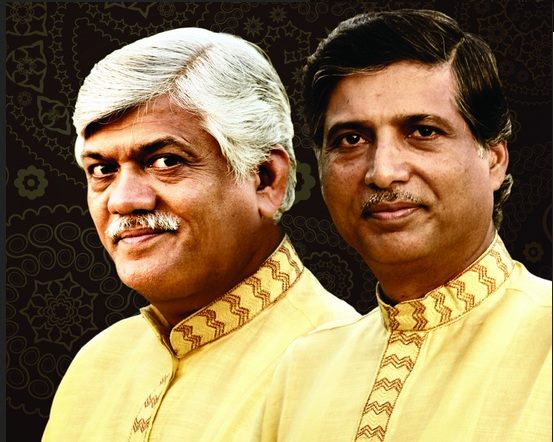
The best change that we witness as teachers is the openness that today’s society cherishes… The openness has come with increased accessibility of different branches of knowledge, which has sharpened the intellect and broadened the horizons far beyond what we could conceive, maybe two decades ago.
On the other hand, in our opinion, while the new generation has astoundingly sharp understanding that helps them grasp subtle nuances of this art; we also see some impatience in some youngsters to enter into the higher orbits of this field.
However, the element of impatience may change with time and experience! Whatever the time may be, reverence and faith in the guru is indeed very important. Nothing can replace devotion, hard-work, sincerity and the genuine intention to understand the knowledge made available by the Guru. We believe that the essence of Guru-shishya tradition doesn’t reside in the constant physical presence of the guru, but it does in being under the constant influence of the guru’s thoughts; the critical sight which gives you the power to distinguish between what is correct and what is not. The guru, in other words, lives inside the student’s mind. Guru pournima is therefore the day when the guru and shishya both remind themselves of the guru who resides in the mind of the student!
In today’s time, it is important that the student must realise, he/she has to learn not blindly, but diligently. The guru, in turn, ought to allow the student the scope and space to understand and assimilate the principles of the knowledge passed in a way that makes it possible for the student to develop his inherent strengths and overcome his weaknesses in his unique way.
The knowledge of the guru must translate into the student’s mind, body and soul, and must not merely be an imprint, a copy, of the guru which is imposed on the mind of the students in the name of tradition.”
As aptly put into words by Gundecha brothers, this Guru Purnima we all will remember and respect our Gurus within ourselves, who reside in the form of their teachings, thoughts and the shared wisdom. As the process of learning never ends; we as disciples will also try to be always diligent and aware while acquiring and practising the knowledge we get from our Gurus in different ways!
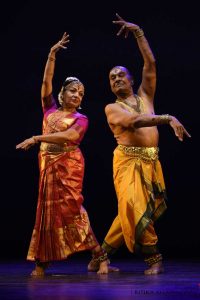
The famous Kuchipudi Dancing couple of India – Kuchipudi Exponents and Gurus Raja and Radha Reddy are also believed to be important figures in bringing Kuchipudi on the cultural map of India! Raja and Radha Reddy also shared their vision and views about ‘Guru-Shishya’ tradition and changing nature of it. They think that the Guru-Shishya Parampara which has been prevalent since the olden days has changed its form and authenticity to a great extent.
“The contemporary meaning of ‘Guru Shishya Tradition’ in Indian Classical Art field is limited to the Guru getting the restricted time to pass on their vast knowledge base to their Shishyas, in a limited time and in a more flexible form and the disciples try their best to grasp the knowledge in the stipulated time provided…
We observe that somewhere the bond between the Guru and the disciples is missing these days owing to the changes the modern generation is experiencing where very little significance is given to the Classical Art forms and they are learnt as acquiring another talent rather than embracing the art.
In olden times, gurus were given the respect of God and they used to influence their students not just for the art they were learning but also the worldwide affairs. Also, the Shishya would devote their all to the Guru as the values and systems were such during those days. All this was possible only because both the Guru as well as Shishya used to follow an extremely strict and disciplined lifestyle with full focus on the learning part. But today, even if the Gurus wish to pass on their knowledge to the Shishyas, the Shishyas are not able to take the whole of learning and it is confined to trying only to grasp the knowledge without understanding the intricacies of the art form due to the societal expectations and pressures. The disciples cannot be solely blamed for it as they are always balancing and juggling up between their academics and learning various other things that have become necessity for the current era.
[adrotate group=”9″]
According to Raja and Radha Reddy, if the Shishyas make efforts to imbibe the spirit of the Guru along with grasping the theoretical part, that itself can be likened to giving full respect to their Gurus and would be more relevant to the Gurus to celebrate the occasion of Guru Purnima.
In today’s time, the Guru should also be able to impart the knowledge and understanding to the students keeping in mind the practicalities of the current society- time constraints and the pressures students face in every walk of their lives.
This would help the Guru as well as the Shishya to exchange their energies in a more synchronised manner. Also, the Shishya must be open to the learning imparted by the Guru and devote whole-heartedly for whatever time they have in hand. This openness to learning would help them to absorb the strength of their Guru in the correct form. Preservation of the Guru-Shishya tradition and our heritage requires one to put in lots of ‘Sadhna’ for the same i.e. the correct understanding and vision behind our motto to safeguard our traditions. We can always modernize the art form but the ‘Grammar’ of the art has to be intact. As far as the collaboration is concerned, there has to be a proper understanding and respect by both the Guru as well as Shishya about the need and requirement of the current times. Gurus and disciples both need to understand today’s time and need and work in unison to preserve this age old tradition and sacred relationship between the two!”
Yes, as Raja and Radha Reddy ji mentioned, there needs to be a mutual understanding between the guru and shishya to make the learning process more effective, efficient, relevant and meaningful in contemporary era.
When we think about the contemporary Kathak Exponent who has won many hearts across the globe with her unique way of presenting the traditional Kathak style with her contemporary vision, immense perfection and has left her mark in the mind of everyone who has attended her production… Yes! We are talking about ‘Aditi Mangaldas!

Aditi Mangaldas was fortunate to get great Kathak stalwarts and icons like Smt. Kumudini Lakhiya (Kumiben) and Pt. Birju Maharajji as her Gurus… the wide vision of Kumiben helped Aditi ji expand her frontiers and the deep vision of Pt. Birju Maharaj helped in re-exploring the frontiers over and over again! Aditi ji tells us, “Guru-shishya relationship is a beautiful relationship where learning is not limited to only one topic of interest but it fosters ‘holistic learning’. From Kumiben, I learnt the process of exploring this tiny, fragile body with the rest of humanity, space and other components of presentation like poetry, stage designs, etc. And with Maharajji, it was more about finding the centre of the body and from there, reaching to the smallest part of our body and to energise these body parts which help us dance holistically with full sense of awareness…
When we talk about the changing nature of Guru-shishya tradition, I think everything changes with time so is this tradition, but what really needs to change according to today’s time is the ‘questioning attitude’! One should have deep respect, love and affection towards his/her Guru but one should not try to just imitate the Guru but needs to have a capacity to think on his/her own. I would rather be a terrible original than an excellent copy!
Gurus need to encourage students to think and question rather than moulding them according to Guru’s understanding of life experiences. Gurus also need to let the students free to explore and expand their knowledge and vision.
Eventually, under the Banyan tree; nothing grows! Respect remains but letting go is important; Guru goes on his/her own journey so does the disciple.. or there comes a point when Guru-shishya hold hands and go ahead together… I feel, in any Guru-shishya relationship, ‘give and take’ of ideas, knowledge, thoughts is very important.
I only have four students, I have learnt a lot from them and I’m thankful to them for this constant process of learning. There is no one ‘ideal image’ for the Guru/Shishya as it is a very subjective, personal perspective; but for me I think, the component of ‘Fear’ has to be removed as with ‘fear’, one cannot have the openness and freedom in the process of learning and exploring; eventually which would hinder the process of personal and professional growth!
Gurus and disciples shouldn’t take each other for granted but there needs to be a bond of friendship, equal respect for each others’ capacities between them- which will strengthen the relationship and would also support the process of teaching and learning.
For my students, I kept their personalities, interests, backgrounds, etc. in my mind while teaching; thereby making it an individualized process of learning for each one of them!
Today when we talk about the relevance and meaningfulness of ‘Guru-Purnima’ celebration, I feel any festival/occasion is a ‘Celebration of life, people around us’! Guru purnima is also one of such occasions where we celebrate thankfulness, gratefulness and acknowledgment in the ‘Guru-shishya’ relationship! It is not limited to one day but you stay with it forever, it becomes a part of your everyday ritual and doesn’t become a burden only once a year! It is not an occasion to celebrate only for the students but even Gurus/teachers need to be thankful to their students; because without them there can’t be any meaning to ‘Guru Purnima’. Just like any other tradition, ‘Guru-Shishya’ tradition is also a flow, ever flowing river and that’s why it has reached us! In this ever changing process, everything undergoes change- Something remains, something changes and something disappears – that’s Life!.
[adrotate group=”9″]
Any tradition or vast amount of inherited knowledge from our Gurus shouldn’t be a burden but it should be liberating– it needs to breath fresh, today’s air to let it grow bigger in today’s time! Knowledge and tradition are like deep roots of this ever growing and evolved wisdom, experience and exploration! Preservation of such age old traditions and relation needs to happen through constant exploration and conservation…”
I absolutely resonate with the thoughts of Aditi ji- one cannot stop the process of change but we need to accept and embrace it with ever changing time and ideas! We need to revisit and revise the concept of ‘Guru Shishya Parampara’ and Guru Purnima to suit the contemporary thoughts and practise in the field of classical art forms! Sometimes, old ideas and traditions become obsolete and hence need the reformation, re-exploration and re-thinking to conserve them with the need of the changing time…
We see that some Gurus and disciples have taken the disadvantage of the freedom, just in the name of a tradition. I feel, demanding exorbitant gifts in the form of Guru Dakshina is exploitation and violation of the true ‘Guru-shishya’ relationship; also disrespecting Gurus or being unfaithful to them is equally responsible to damage this sacred bond and tradition!
All the legendary Gurus, thinkers have shared their thoughts and experiences with us which had given us a broad perspective to think about the changing paradigms of Guru-Shishya Parampara and Guru Purnima… To sum it up, I would like to say that, to keep this rich tradition and heritage of our Indian culture going, Gurus and Shishyas need to be mindful, aware during the process of learning and teaching, have a right attitude and shouldn’t look at each other as competitor but have deep respect towards one other to strengthen the relationship between the Guru and the disciples! Accepting and embracing the changing nature of this relationship and tradition is equally important to pave the path for the younger generations and to give them the freedom to explore, investigate, revisit the relevance and meaningfulness of this tradition in line with today’s time! We hope that, we all will work together to reach the common goal of growth and conservation of ‘Guru shishya’ tradition along with today’s celebration of ‘Guru Purnima!’



